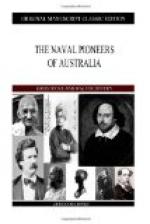“In 1811 he was entered on the books of H.M.S. Roebuck; and, through means of Rear-Admiral Murray, he was, in 1813, placed on board the Indefatigable, naval storeship, under Captain Bowles. In this vessel the young sailor visited New South Wales and Van Dieman’s Land, whence he proceeded to Cape Horn and Cape of Good Hope, and thence, after a short stay at St. Helena, he returned to England. He then left the British Navy, but after remaining a short time at home he received a letter from his old commander, offering to procure him a berth on board a ship of 18 guns, designed for the assistance of the patriots in South America. He accepted this offer, and left England early in 1816 for Valparaiso, but the Royalists having regained possession of that place, he could not enter it until 1817. He afterwards held a commission in the Chilian service, under Lord Cochrane, and was made a lieutenant in it in consequence of his gallantry in the cutting out of the Spanish frigate Esmeralda, of 40 guns, from under the batteries of Callao, and during a severe conflict with a Spanish gun brig near Arauco, a fortress in Chili. In the latter encounter Mr. Nobbs was in command of a craft which sustained a loss in killed and wounded of 48 men out of 64, and was taken prisoner with the survivors by the troops of the adventurous robber General Benevideis. The 16 captives were all shot with the exception of Lieutenant Nobbs and three English seamen; these four saw their fellow prisoners led out from time to time, and heard the reports of the muskets that disposed of them. Ever afterwards he retained a vivid memory of that dreadful fusillade. Having remained for three weeks under sentence of death, he and his countrymen were unexpectedly exchanged for four officers attached to Benevideis’ army. Mr. Nobbs then left the Chilian service, and in 1822 went to Naples. In his passage from that city to Messina in a Neapolitan ship, she foundered off the Lipari Islands; and, with the loss of everything, he reached Messina in one of the ship’s boats. In May, 1823, he returned to London in the Crescent; and in the same year he sailed to Sierra Leone as chief mate of the Gambia, but of 19 persons who went out in that vessel none but the captain, Mr. Nobbs, and two men of colour lived to return. In June, 1824, he again went to Sierra Leone, now as commander of the same craft, and was six weeks on shore ill of fever, but it pleased God to restore him to health in time to return with her; and he resigned command on his reaching England. Meanwhile the captain of a vessel in which he had once sailed had expatiated so frequently on the happiness of the people at Pitcairn, where he had been, that Mr. Nobbs resolved to go thither if his life should be spared; and, with this object in view, he set out on the 12th of November, 1825, in the Circassian, bound for Calcutta, but he was detained there until August, 1827; then, after a narrow escape from shipwreck in the Strait




